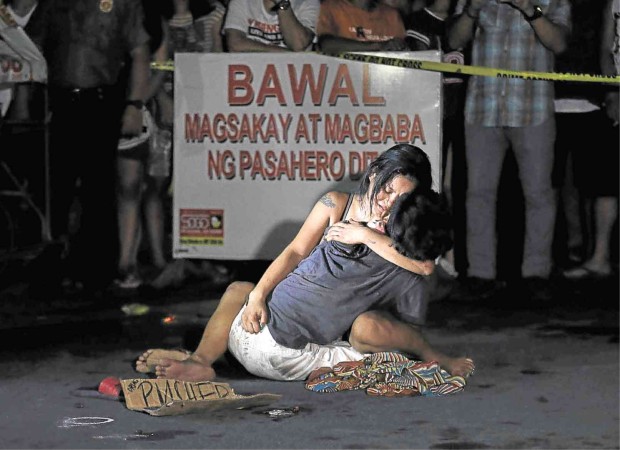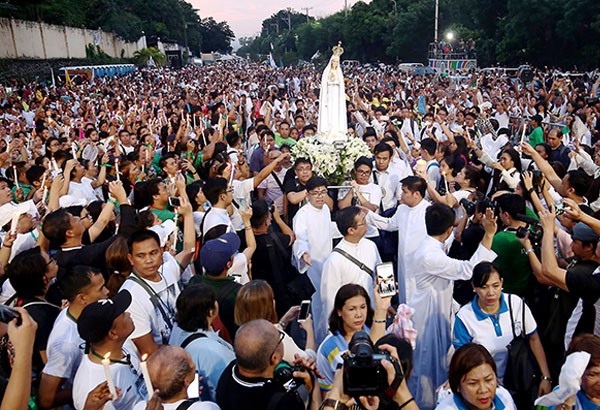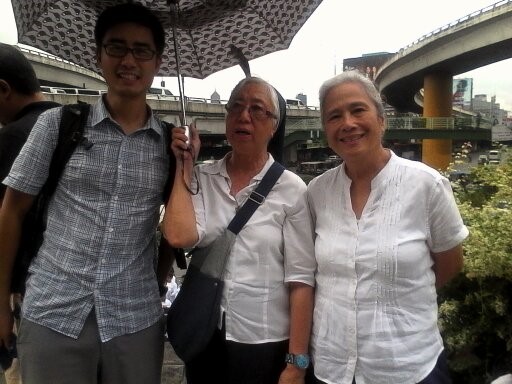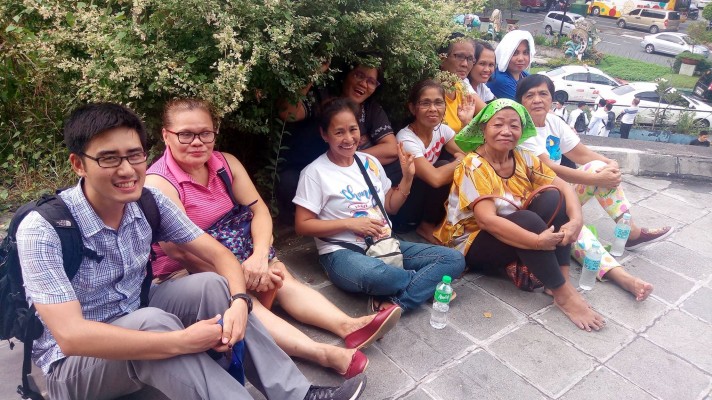By Pierre Thompson, Class XV

A victim of the government’s war on drugs made the front page of the Philippine Inquirer in July 2016. (Photo: R. Lerma, reproduced with permission)
Since mid-2016, extrajudicial killings (EJK) associated with President Rodrigo Duterte’s war on drugs have claimed more than seven thousand lives, according to Amnesty International, raising significant concern over human rights violations. Last year, as many as 32 people were killed in Metro Manila in a single night. [1] The municipality where I live has been heavily impacted by EJK due to its high concentration of the urban poor. The war on drugs may be understood as a war on the urban poor who tend to live in informal settlements; it does not threaten the affluent in their gated subdivisions.
During my time in Metro Manila, I have visited the urban poor and heard stories from bereaved family members of EJK victims. One woman begged the death squad to spare her 24-year old daughter so that she could at least visit her in prison; they shot her daughter execution-style in front of the family. Another woman prayed that the death squad would kill only her brother or his wife so that the children would not become orphans; they murdered both parents. The vigilantes showed no regard for human dignity, or due process, or trauma inflicted upon family members.
An extremely disturbing aspect of EJK is the hidden profit motive behind each killing. The mortuary typically arrives shortly after the incident to claim the corpse, and charges 15,000 pesos to release the body of the deceased. Because this is an impossible amount for urban poor families to pay, many victims never receive proper burial. It is rumored that the vigilantes also receive 15,000 pesos for each EJK they carry out.
Holistic Care
The Philippine Catholic Church, having been lax in addressing the social crisis of drug addiction, was jolted into action. While church leaders supported the eradication of illegal drugs, they opposed the government’s methods based on their principal commitment to protect human life. In the end, they devised a strategy that defined the role of the Church as social facilitation/dialogue, psycho-social education, pastoral counseling, spiritual healing, and provision of sanctuary and volunteers.
When the war on drugs broke out last year, many drug suspects sought counsel from the church on whether to surrender to the police or to flee. Because the police had no protocol for removing a person whose name had been added to the watch list, the church initiated a dialogue with the Chief of Police and local government officials. The church negotiated a special truce: on September 1, 2016, forty people whose names were on the watch list surrendered in exchange for a promise by police that they would not be harmed. Since then, more than 13,000 people have surrendered peacefully through the facilitation of the church.
“The response to addiction is not sobriety but connection,” explained a parish priest. “We have to connect the drug user to himself or herself, to family, to community, to one another.” There are now six community-based drug rehabilitation program (CBDRP) centers throughout the diocese where drug users can seek treatment. The rehabilitation of drug addicts involves a clinical, spiritual, and vocational dimension. Furthermore, the church provides holistic care for drug users, their families, and the affected communities; but the recovery process is long and costly. I strongly encourage Rotarians, as well-connected professionals within the community, to develop programs of educational assistance and livelihood opportunities for survivors.
Civil Resistance
The Center for Peace Education, where I am interning, exhorts the government to find nonviolent solutions to the drug problem. In September, Cardinal Luis Antonio Tagle invited parishes in Metro Manila to participate in a “Stop the Killings” campaign by reciting the rosary, tolling church bells and lighting candles every 8 p.m. because the death squads usually come out around that time. The nonviolent campaign culminated on November 5 with a mass at the historic EDSA Shrine and a procession to the People Power monument. The Catholic Bishops’ Conference of the Philippines, which organized the event, described it as “a religious activity that will gather the faithful to pray for forgiveness and the country’s healing amid the spate of extrajudicial killings.”
The event was full of symbolism. The mass began at 3 p.m. which the Catholic Church considers the hour of Divine Mercy. The principal celebrant, Archbishop Socrates Villegas, delivered a stern warning in his homily: “No government lasts forever. Only God is forever. Power belongs to the people not the power-holder.” Archbishop Villegas himself was a protégé of Cardinal Jaime Sin, who had been a major force in the 1986 People Power Revolution. After the mass, the revered image of Our Lady of Fatima, which had been used in the 1986 People Power Revolution, was again processed along EDSA to the People Power monument one kilometer away.
The Philippine Inquirer estimated that 20,000 people turned out to the monument to pray for peace. I attended the event with friends from Pax Christi Philippines; Miriam College; the Religious of the Good Shepherd; and the Congregation of Jesus and Mary. It was extraordinary to witness both religious and political leaders strongly united against EJK. I even shook hands with Former Vice President Jejomar Binay at the event. Senators issued the following statement about the procession: “We hope the united prayers of the prelates and the faithful will stir the inner voice of our leaders and those who kill the helpless to stop wasting lives and mend their ways.”

Twenty thousand people attended a mass and procession, organized by the Catholic Bishops’ Conference of the Philippines, “to pray for forgiveness and the country’s healing amid the spate of extrajudicial killings.” (Photo: Philstar Global)

“Pedrito” Thompson, Sister Carmelita and Sister Florence of the Religious of the Good Shepherd. This busy intersection in Manila was the site of nonviolent protest during the People Power Revolution in 1986.

“Pedrito” Thompson taking a break with mothers from Miriam College’s urban poor communities.
[1] http://www.cnn.com/2017/08/16/asia/philippines-duterte-war-on-drugs-deadly-night/index.html

